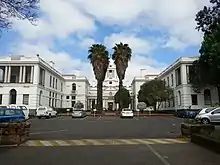 | |
 | |
| Agency overview | |
|---|---|
| Formed | 2001 |
| Preceding agencies |
|
| Jurisdiction | South Africa |
| Employees | ≈ 8000 |
| Annual budget | |
| Parent department | Department of Health |
| Key documents | |
| Website | www |
| Map | |
The National Health Laboratory Service (NHLS) is a South African national government institution established in 2001. It was created by merging the South African Institute for Medical Research (SAIMR), the National Centre for Occupational Health and the National Institute for Virology. It also absorbed various provincial health department and university-run pathology laboratories.[4]
The NHLS is the diagnostic pathology service for the public sector in South Africa. A network of 265[5] laboratories service all public hospitals and clinics in the country.[6]
Divisions and subsidiaries
Besides the network of pathology laboratories operated by the NHLS the institution also has a number of specialist divisions:
National Institute for Communicable Diseases
The National Institute for Communicable Diseases (NICD) was created by combining various structures inherited from the NHLS's parent organisations. The former National Institute for Virology was combined with the former SAIMR's specialist laboratories of microbiology, parasitology, and entomology to create a communicable diseases institute with a public health orientation, comparable to the Centers for Disease Control and Prevention of the United States.[7]
National Institute for Occupational Health
The National Institute for Occupational Health (NIOH) investigates occupational diseases and performs occupational environment analysis through a variety of services which include statutory autopsy, advisory and information services, health hazard evaluation and specialist laboratory services.[8]
The services and units of the NIOH are:[8]
- Analytical Services
- Asbestos Information, Identification, Counting, Monitoring and Evaluation Services
- Autopsy Examination Services
- Bioaerosol Monitoring Unit
- Compensation Service
- Diagnostic Services
- Electron Microscopy Service
- Epidemiology Surveillance
- Ergonomics Unit
- Genotoxicity Assessment Unit
- Health Risk Assessment Unit
- Industrial Toxicology Information Services
- Library Services
- Micro and Nano - Particle Sizing
- Occupational Allergy Unit
- Occupational Health Risk Assessments
- Occupational Hygiene Audits
- Occupational Hygiene Surveys
- Occupational Medicine Referral Clinic
- Particle Toxicology/Nanotoxicology Unit
- Query Handling Service
- Toxicogenomics Unit
- Waterborne Pathogens Unit
National Cancer Registry
The NIOH also manages the National Cancer Registry which is responsible for analysing newly diagnosed cancer cases and to report annual cancer incidence rates. The NCR collects data from public and private histopathology, cytology and haematology laboratories across the whole country.[9]
South African Vaccine Producers
South African Vaccine Producers (SAVP) is a subsidiary of the National Health Laboratory Service, responsible for manufacturing vaccines and antivenoms. SAVP's Antivenom Unit is the only manufacturer of antivenom for a number of venomous snakes found in Africa as well as scorpion and spider antivenom.[10]
Antivenom shortage
At the beginning of 2022 and for the following year, South Africa experienced a shortage of antivenom. The South African Vaccine Producers said that they faced several challenges, including equipment failure due to power outages and supply issues. Questions were raised as to why a five-year supply declined to a shortage of antivenom. The National Health Laboratory Service said it distributed antivenom to 124 facilities but demand was still exceeding supply.[11][12][13]
Training
The NHLS is involved in training all pathologists in South Africa through its partnerships with all nine of the medical schools at South African universities.[5]
Research
The NHLS is involved in pathology and health surveillance research through the pathology laboratories it runs at the medical schools. The partnerships with universities concentrate on a few priority areas; HIV/AIDS, tuberculosis, malaria, occupational health, malnutrition prevention, cervical cancer screening and pneumococcal infections.[5]
Controversy
During 2011 the Treatment Action Campaign, an HIV/AIDS non-governmental organisation criticised the national government for allowing the financial viability of the NHLS to be threatened due to the failure of the health departments of Gauteng and Kwa-Zulu Natal to pay the NHLS for services rendered.[14] The financial problems continued into 2012.[15]
References
- ↑ "NHLS Annual Report 2019-20" (PDF).
- ↑ "NHLS Annual Report 2020-21" (PDF).
- ↑ "National Health Laboratory Service Annual Review 2021/22" (PDF).
- ↑ "National Health Laboratory Service | Who Are We?". Nhls.ac.za. Retrieved 2013-12-16.
- 1 2 3 "National Health Laboratory Service - Company Reports - African Business Review - Report". Healthcare Global. Archived from the original on 2013-12-16. Retrieved 2013-12-16.
- ↑ "National Health Laboratory Service | Diagnostic Services". Nhls.ac.za. Retrieved 2013-12-16.
- ↑ "South Africa". Ianphi.org. Retrieved 2013-12-16.
- 1 2 "National Institute for Occupational Health | Services". Nioh.ac.za. Retrieved 2013-12-16.
- ↑ "National Health Laboratory Service | National Cancer Registry". Nhls.ac.za. Retrieved 2013-12-16.
- ↑ "National Health Laboratory Service | Antivenom Unit". Nhls.ac.za. Retrieved 2013-12-16.
- ↑ Ellis, Estelle (2023-04-20). "SERUM SCARCITY: SA increases production of snake antivenom but shortage not over yet". Daily Maverick. Retrieved 2023-05-02.
- ↑ "South Africa has a shortage of snake antivenom. This is why it matters".
- ↑ Zyl, Corné van (2023-04-17). "How is SA's five-year snake-antivenom supply DEPLETED?". The South African. Retrieved 2023-05-02.
- ↑ "National Health Laboratory Service facing collapse - TAC" (Press release). Politicsweb. Retrieved 2013-12-16.
- ↑ Tamar Kahn (2012-10-10). "National Health Laboratory Service still struggling with tardy provincial payments | Healthcare". BDlive. Retrieved 2013-12-16.